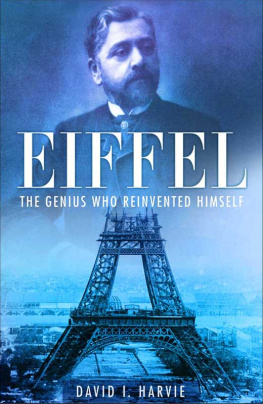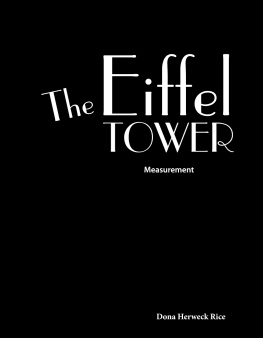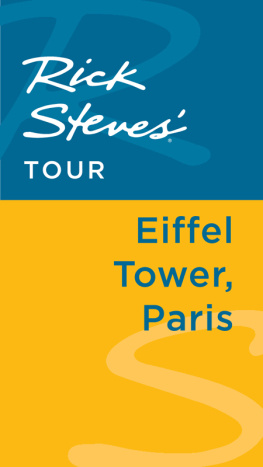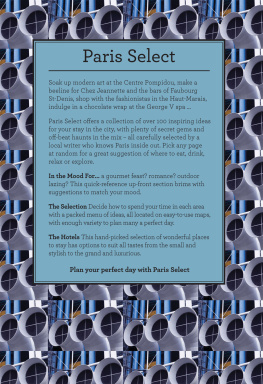EIFFEL
For Rose Harvie
and
Maggie Anne Cullen Harvie
EIFFEL
T HE G ENIUS WHO R EINVENTED H IMSELF
DAVID I. HARVIE

First published in 2004 by Sutton Publishing
This paperback edition first published in 2006
The History Press
The Mill, Brimscombe Port
Stroud, Gloucestershire, GL5 2QG
www.thehistorypress.co.uk
This ebook edition first published in 2013
All rights reserved
David I. Harvie, 2004, 2013
The right of David I. Harvie to be identified as the Author of this work has been asserted in accordance with the Copyrights, Designs and Patents Act 1988.
This ebook is copyright material and must not be copied, reproduced, transferred, distributed, leased, licensed or publicly performed or used in any way except as specifically permitted in writing by the publishers, as allowed under the terms and conditions under which it was purchased or as strictly permitted by applicable copyright law. Any unauthorised distribution or use of this text may be a direct infringement of the authors and publishers rights, and those responsible may be liable in law accordingly.
EPUB ISBN 978 0 7524 9505 7
Original typesetting by The History Press
Contents
Acknowledgements
W hen the suggestion was first made to me that I consider writing this book, my interest was immediately attracted by both the subject and his period in history. I believe there is always something especially curious and attractive about those people and events that have not long ago slipped over the horizon of the direct experience of anyone still living. The tantalising sense of intangibility that often precedes the fully rooted and well-understood place in history has an attraction of its own. In Britain at least where Eiffel is surely less well known than he deserves I hope the books subtitle will offer an intriguing hint of the progressive and public-spirited way in which he reacted to the extraordinary events that befell him and which caused him to reorganise his working life.
In addition to Eiffels many published works (some of them dauntingly heavy with technical and mathematical detail) and contemporary sources from France, Britain and the United States of America, I have drawn on previous books on the life of this internationally significant polymath. Many of these have now been long out of print. In particular, I draw attention to four volumes: Franois Poncettons Eiffel, Le Magicien du Fer, published in Paris in 1939; Joseph Harrisss The Eiffel Tower, Symbol of an Age, published in London by Paul Elek in 1976 (and originally published by Houghton Mifflin the previous year in New York as The Tallest Tower); Bertrand Lemoines Gustave Eiffel, published in Paris in 1984; and Henri Loyrettes Gustave Eiffel, published by Rizzoli in New York in 1985 (translated by Rachel and Susan Gomme), and originally published in 1985 as Eiffel Un Ingnieur et son Oeuvre by the Office du Livre SA, Fribourg, Switzerland.
I am grateful to the staffs of a number of libraries, including the British Library and the Newspaper Library at Colindale; Glasgow University Library, in particular the Special Collections Department; the National Library of Scotland in Edinburgh; and the Mitchell Library in Glasgow. I appreciate the hospitality and assistance of both the Librarian and the Archivist of the Institution of Civil Engineers in London; and I acknowledge the assistance of the Agence Roger-Viollet in Paris and the US Library of Congress in Washington in relation to illustrations. Iain Lewicki has tried to ensure that my translations from French have been reasonably accurate and consistent (not always straightforward given the use of technical terms and changes in idiom and style since the 1880s); and I thank Michel Schepens for kindly agreeing the use of the image of a particularly fine film poster. I am grateful to M. Jean Alex Foret of La Socit Nouvelle dexploitation de la Tour Eiffel, who very kindly drew my attention to new information that has come to light concerning the elevator systems for the Tower. This has allowed corrections both to this new edition and to the official Eiffel Tower website. My wife Rose has as usual acted as a kindly critic, and Jaqueline Mitchell at Sutton has brought valuable editorial dispassion.
Introduction
Towered cities please us then,
And the busy hum of men.
Milton, LAllegro 1.117
T he urge to build towers is as old as man, and has produced an extraordinary range of structures, spectacularly diverse in both design and purpose. This compulsion to build to a height considerably greater than the structures width often manifested superiority over neighbour, rival or enemy. Towers have been erected in honour of deities or to gain closeness to them, to celebrate places of worship, and to proclaim spiritual or intellectual resolve. They have also been built to assert position, power, wealth and prestige, to affirm cultural dominance or to intimidate. Towers with such symbolic purposes usually had little strictly practical use, while those with a demonstrable practical purpose, such as the defensive watch-tower, windmill or lighthouse, have generally been relatively insignificant. Often, seen from todays perspective, the original purpose is, if not lost, then blurred by our willingness to admire the after-effect. This is true of the Tuscan hill town of San Gimignano in Italy, where in the fourteenth century feuding families built over seventy successively higher towers to demonstrate their superiority; today, the result of tribal display is admired by visitors for its unique townscape effect.
The oldest man-made towers, on royal castles near the EgyptNubia border, may be 5,000 years old, and Sardinia is reckoned to have had over 7,000 nuraghi, or round stone towers dating from 1,500 BC (of which 300 remain). The ziggurat mountain dwellings of ancient Sumaria, which developed as stepped, manmade, pyramid-shaped structures surmounted by religious temples reaching for the gods, began a tradition that lasted for thousands of years. The name that best survives is probably the Tower of Babel, which was built on the ruins of earlier towers in the sixth century BC at Babylon, in the fertile valley between the Rivers Tigris and Euphrates in Mesopotamia (modern Iraq). A few ancient written references and rather more archaeological evidence together prove the existence of a seven-storey tower of baked, brilliant-blue enamelled brick which did not conform to the greater height than width definition each side appears to have been about 300ft in length, approximately equalling its supposed height.
The story of the Tower of Babel has come to us (and been mightily recycled) from the biblical tradition, in which a jealous Old Testament God reacts against the arrogance of its collaborating builders:
And the Lord came down to see the city and the tower, which the children of men had builded. And the Lord said, Behold, the people is one, and they have all one language; and this they begin to do; and now nothing will be restrained from them, which they have imagined to do. Come, let us go down, and there confuse their language, that they may not understand one anothers speech.
(Genesis 11: 57)
Gustave Eiffel is a national hero in France but is perhaps uniquely remembered in Britain and elsewhere for his famous iron tower, which has survived long beyond its expected twenty years and has become possibly the worlds most recognised structure. This extraordinary 986ft tower was deliberately built for Pariss Exposition Universelle of 1889, to be the tallest building in the world at a time when national self-worth was being energetically driven by a series of great international exhibitions. However, before Eiffel had riveted his first two pieces of iron together at the Champ de Mars, he and his proposed tower were publicly pilloried in what became known as the Artists Protest, when the intellectual elite combined to pour scorn on his proposal. The great battle of Art versus Industry a battle intended to be annulled by the very concept of the international exhibition became focused on the tower. However, the impetus behind the 1889 exhibition was enough to forestall the protest, and Eiffel, who had taken personal financial responsibility for the entire 8-million-franc project, proceeded to build what has become perhaps the most iconic structure in the world.
Next page











